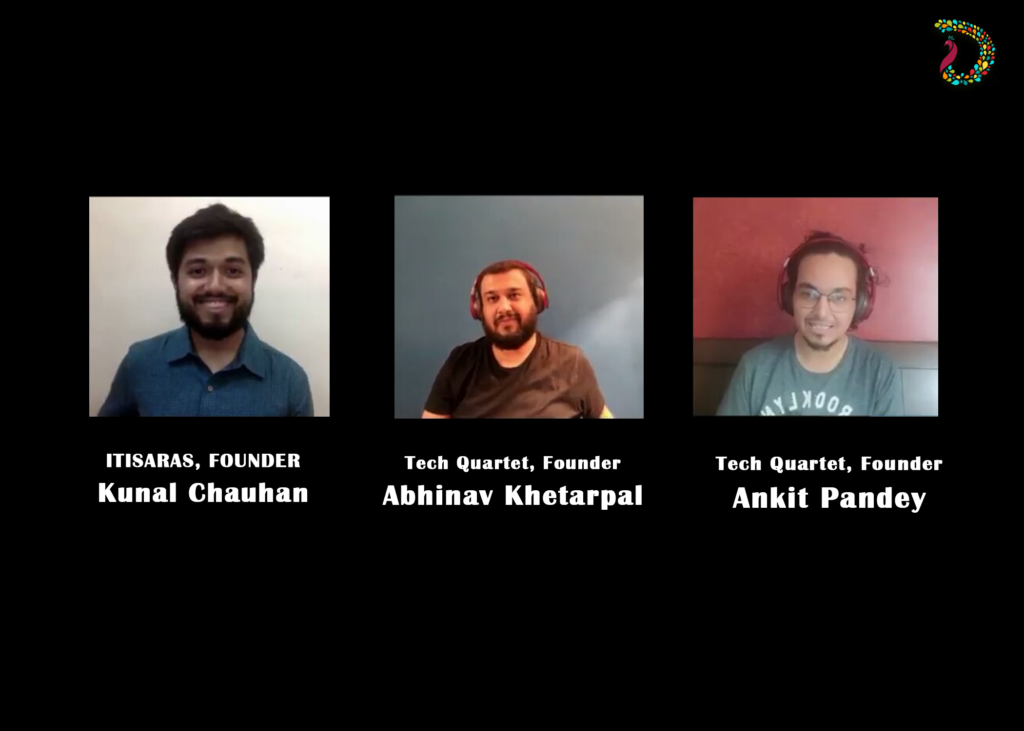
In the light of the ongoing edition of the Dhaara Magazine— Art on the Edge: Performing Arts in Pandemic— we, the team of Itisaras organized and conducted an interview with Ankit Pandey and Abhinav Khetarpal: two of the founding members of TECH QUARTET. The Quartet is a technical design collective based in New Delhi. Over the years, they have designed lighting and visuals for a wide gamut of performances across theatre productions, dance recitals, Concerts, and Art Installations. Apart from live performances, they have also designed performance venues and offer technical consultation as well as ground support.
The interview started with an interesting story about the inception of the idea that led to the company’s establishment. All four founders were members of the dramatic society of Kirori Mal College, Delhi University, and as Ankit recalls it all started with the technical parts being treated as an integral part of the performance, which wasn’t customary in other colleges. Although they all had an inclination towards the technical aspects of performances, it wasn’t until a few years ago that they all came together to form the company. It started with lighting – designing as the primary area of work but as new projects came in, like art festivals, requirements for visual representations, the company branched out in other areas too.
So when we asked them about the pandemic ramifications for this unconventional line of work, the answer was quite obvious. For the Government, the artists, performers and technical staff of the industry were headings under the crimson title of ‘non-essential’ even when these people worked to serve everyone else at their comfort. Abhinav rightly asked us, ‘if there was no art, would you be able to sit at home?’ With no live performances happening the fieldwork was totally called off, not just for their lighting-designing team but also for the vendors who supplied pieces of equipment for various shoots. In fact, a month before the second wave hit people were accepting the new normal and going out, which provided some work for the industry but post the second wave, it’s been absolutely quiet.

The next question was related to the new mode that artists have adopted to stay relevant in the pandemic and how it has affected the technicians like the TechQuartet. Here Abhinav rightly pointed out the new realization that people have had over pandemic: the concept of working The new model has rendered technicians redundant. Another realization that our interviewees shared was the fact that this online mode is here to stay, and no one can see things getting better anytime soon for the industry. This, on one hand, has been saving a lot of money for some people, and on other hand has sent back experienced technicians to become farmers. from home, and so for the people who can work from home they are getting way too comfortable doing so. For the artists this means self-sufficiency in the technical parts of performances; they have begun doing their own lighting-designing at home, which has been as easy as using a lamp or directing the sunlight for the camera.
Discussing the future of technical work, Abhinav talks about expanding their avenues to providing music videos and films, and not just performances. He thinks this will help in sustaining them and the company. While Ankit, finds this new set-up very convenient for actors and directors, he thinks it is the technical staff who have been taking the brunt of it.
Lastly, when asked about getting any help from the government, the answer was a sad ‘No’. The technicians have been ignored due to the unstructured nature of the performance arts industry in our country in particular. While countries like Canada, Netherlands, Lithuania have been providing help to their artists for their survival, in India we are still struggling to consider performance arts—and its related work—a profession. In fact, our interviewees considered it a privilege to sit at their home and participate in this interview as they have just accepted that there will be no help, even someone hearing their plight would be enough.
Click below to watch the full video:
We, at Itisaras, believe that awareness and action are integral for change, and for the same we have launched a petition on change.org that urges the Ministry of Culture to extend institutional support to the people of the Performance Arts sector. Please join us and sign the petition – http://chng.it/zhFTnGdPMm



